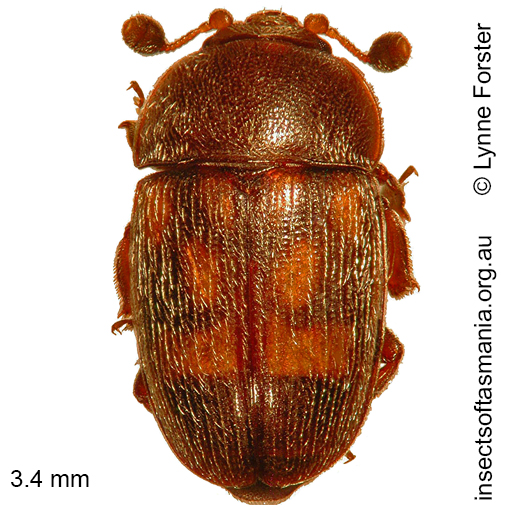
Thalycrodes pulchrum Blackburn, 1891 (a species of sap-beetle)
Basis for Tasmanian occurrence
Semmens, T.D., McQuillan, P.B. & Hayhurst, G. (1992). Catalogue of the Insects of Tasmania. Government of Tasmania: Department of Primary Industry, 104 pp. (as Thalycrodes pulchrum)
TMAG collections
Classification
Order: Coleoptera
Suborder: Polyphaga
Superfamily: Cucujoidea
Family: Nitidulidae
Subfamily: Nitidulinae
Tribe: Nitidulini
Morphology
Typical length (mm): 3.4
Flightedness: winged and assumed capable of flight
Morphology (characterised by L. Forster): — Antennae with large, compact, globular, three-segmented club — Elytra broad and dark with pale-orange spots — Fore-tibiae evenly crenulate on outer edge, without prominent teeth.
Source literature on morphology and taxonomy (*primary taxonomic source, where identified):
*Blackburn, T. (1891a). Further notes on Australian Coleoptera, with descriptions of new genera and species: IX. Trans. Roy. Soc. S. Aust. 14: 65-193.
Kirejtshuk, A.G. & Lawrence, J.F. (1992). Review of the Thalycrodes complex of genera (Coleoptera: Nitidulidae) endemic to the Australian Region. Journal of the Australian Entomological Society 31: 119–142.
Ecology
Assumed larval feeding: detritivore
Association with dead wood or old trees: at least facultatively saproxylic
Ecological attributes: — Affiliated with burnt tree-wounds (Harrison, 2007) — Affiliated with lowland (<500 m altitude) wet forest (Forster & Grove, 2009) — May occupy logs or trunks of Eucalyptus obliqua, at least temporarily, since found having emerged within a year of felling (Grove & Bashford, 2003) — May occupy logs or trunks of Eucalyptus obliqua, at least temporarily, since found having emerged within six years of felling (Grove et al., 2009).
Collection method(s) for TMAG material: — Baited trapping (funnel trap) — Emergence trapping from log of Eucalyptus obliqua — Flight intercept trapping (trough below Malaise trap) — Log-mounted flight intercept trapping — Malaise trapping — Pipe trapping — Pitfall trapping — Sticky trapping on Eucalyptus obliqua.
Source ecological literature:
Grove, S.J. & Bashford, R. (2003). Beetle assemblages from the Warra log decay project: insights from the first year of sampling. Tasforests 14: 117-129.
Grove, S.J. (2009b). Beetles and fuelwood harvesting: a retrospective study from Tasmania’s southern forests. Tasforests 18: 77-99.
Baker, S.C. (2000). Forest litter beetles and their habitat: a comparison of forest regenerated by wildfire and logging practices. Hons. thesis, Univ. of Tasmania, Hobart.
Baker, S.C. (2006b). Ecology and conservation of ground-dwelling beetles in managed wet eucalypt forest: edge and riparian effects. PhD thesis, Univ. of Tasmania, Hobart.
Grove, S. et al. (2009). A long-term experimental study of saproxylic beetle … succession in Tasmanian Eucalyptus … logs… In: Fattorini, S. (Ed.), Insect Ecology and Conservation. Research Signpost, pp. 71-114.
Grove, S.J. & Yaxley, B. (2005). Wildlife habitat strips and native forest ground-active beetle assemblages in plantation nodes in northeast Tasmania. Aust. J. Entom. 44 (4): 331-343.
Harrison, K.S. (2007). Saproxylic beetles associated with habitat features in Eucalyptus obliqua trees in the southern forests of Tasmania. PhD thesis, Dept. of Zoology, Univ. of Tasmania, Hobart.
Yee, M. (2005). The ecology and habitat requirements of saproxylic beetles native to Tasmanian wet eucalypt forests: potential impacts of commercial forestry practices. PhD thesis, Univ. of Tasmania, Hobart.

